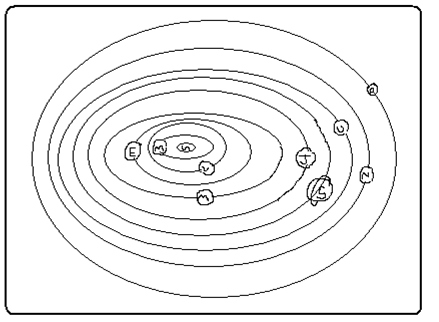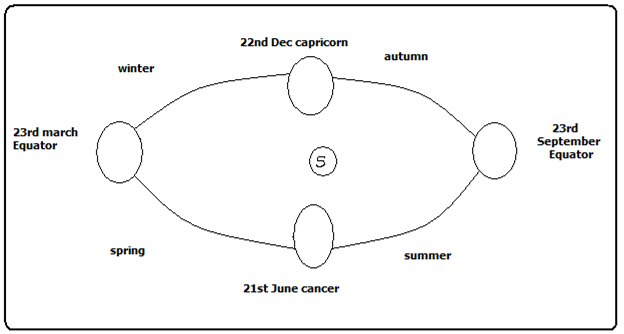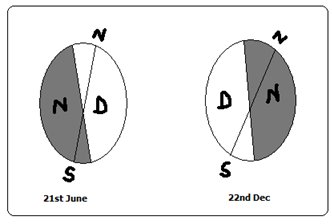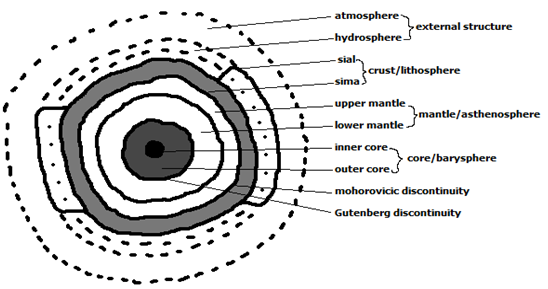- The Earth And The Solar System
- Rotation Of The Earth
- Revolution of the Earth
- The Internal Structure Of The Earth

The Earth And The Solar System
Solar system is the group of heavenly bodies comprising the sun and the planets.
The Origin Of The Solar System
- The passing star theory
A star with a greater gravitational pull passed near the sun
It attracted large quantities of gaseous materials from the sun
The materials split, cooled and condensed to form planets
The planets were set in orbit by the passing star - The nebula cloud theory
There was a slowly rotating cloud of dust and gas called Nebula
It cooled and began to contact
Rotation speed increased and successive rings of gaseous materials were formed.
The rings condensed to form planets
The central gaseous material remained as the sun
Size of the earth
Equatorial diameter-12756km
Equatorial circumference-40085km
Polar diameter-39995km
Surface area of the earth-510×106 km2
Water surface - 73%.
Mercury
Nearest from the sun
Its 58m km from the sun
Has no satellites
Takes approximately 88 earth days to revolve around the sun
Venus
2nd planet from the sun
It’s 108m km from the sun
One of the brightest planets
Can be seen clearly with naked eyes
Takes approximately 225 earth days to revolve around the sun
Slightly smaller than the earth
Has no satellites
Together with the earth they are called twin planets due to having many similarities
Mars
Also called The Red Planet because when it’s observed through a telescope it appears reddish.
The 4th from the sun
Slightly smaller than the earth
Approximately 228m km from the sun
Takes 687 earth days to revolve around the sun
Between Mass and Jupiter there are small celestial bodies called planetoids.
Has no satellite.
Jupiter
5th planet from the sun
Approximately 778m km from the sun
Largest in the universe
Rotates on its own axis at very fast speed
Has flattened poles due to its fast speed of rotation
Has very thick layers of ice on its surface
takes 12 earth years to revolve around the sun
Has 16 satellites
Saturn
6th planet from the sun
Second largest planet
Approximately 1427m km from the sun
Takes 29 ½ earth years to revolve around the sun
Has a ring around it
Has 18 satellites
Uranus
7th planet from the sun
About 4 times bigger than the earth
Approximately 2870m km from the sun
Also rotates very fast
Also has flattened poles due to fast speed of rotation
It appears greenish foe being surrounded by methane gas
Has 8 satellites
Takes 84 earth years to revolve around the sun
Neptune
One of the farthest from the sun
8th planet from the sun
Approximately 4497m km from the sun
Has 8 satellites
Takes 165 earth years to revolve around the sun
Very similar in size, colour and character with Uranus
The shape of the earth
The shape of the earth is called geoid/ovoid/oblate spheroid due to being an imperfect sphere by being wide at the equator and flat at the poles.
The Position Of The Earth In The Solar System
The 3rd planet from the sun
The earth and the heavenly bodies make the universe
The only planet that supports life
The home of man
Approximately 149m km from the sun
Takes 365 ¼ days to revolve around the sun
Has one satellite, the moon

Rotation Of The Earth
Movement of the earth on its own axis (imaginary line through the centre from N pole to S pole
Rotates through 360º
Takes 24 hours (day) to complete 1 rotation
Rotates in an anticlockwise direction (west to east)
Effects of Rotation of the Earth
- Creates day and night because at any one time one side of the earth faces the sun (day) and the other remains in darkness (night).
- Causes deflection of winds and ocean currents in the N hemisphere to the left and in the S hemisphere to the right.
- It causes rising and falling of ocean tides.
- Causes time difference between longitudes
Effects of Rotation of the Earth on human activities
| Effects of Rotation | How rotation affects human activities |
| Day and night | Planning day and night activities |
| High and low tides | Helps in fishing activities Sea transport - |
| Deflection of winds and ocean currents |
|
| Time difference |
|

Revolution Of The Earth
- Movement of the earth in its orbit around the sun.
- It’s in anticlockwise direction.
- The orbit of the earth’s revolution is elliptical.
- Takes 365 ¼ days in a year or 366 days in a leap year (every 4 years).
- The sun moves from the tropic of cancer to the equator and then towards tropic of Capricorn and back to the tropic of cancer.
- 21st march and 23rd September are called equinoxes because the length of day and night is equal. The sun is vertically overhead at noon at the equator.
- 21st June is called summer solstice because its summer in the N hemisphere. The sun is vertically overhead at noon at the tropic of cancer.
- 22nd December is called winter solstice because its winter in the S. hemisphere. The sun is vertically overhead at noon at noon at the tropic of Capricorn.
- Solstice is the period of maximum tilting of the earth towards the sun.
Effects Of The Revolution Of The Earth
- Causes the four seasons summer, autumn, winter and spring due to the movement of overhead sun causing changes in the heat belt.
- Causes variation of day and night’s lengths due to the earth’s axis being inclined to the path of revolution at an angle of 60◦.
- Equinoxes have equal lengths of day and night.
- Summers have longer days and shorter nights.
- Winters have longer nights and shorter days.
- Causes changes in the altitude of the midday sun due to the earth’s orbit being elliptical.
- Highest altitude during equinox
- Lowest altitude during solstices
- Causes lunar eclipse due to revolution bringing the earth in line with the sun and the moon.
Effects of the Revolution of the earth on human activities
| Effects of Revolution | How revolution affects human activities |
| Changes in the position of midday sun at different times of the year | |
| Varying length of day and night at different times of the day | |
| Seasons |

The Internal Structure Of The Earth
- Crust/Lithosphere
- Outermost layer of the earth
- Made of soils and other loose deposits of sand
- The dominant rocks are granites.
- Extends 0-50km
- Has 2 layers
- Sial
- Also called continental crust
- Made of light coloured rocks
- Called sial because it’s made up of silica and aluminium.
- Sima
- Also called oceanic crust
- Mainly made of basaltic rocks which are brittle.
- Called sima because it is made of silica magnesium and iron.
- Sial
- Mohorovicic Discontinuity (Moho)
- A definite zone of discontinuity between the crust and the mantle.
- Was discovered by Dr. Andrija Mohorovicic in 1909.
- The Mantle/Asthenosphere
- Layer lying between the crust and the core
- Made of iron and magnesium
- Has two layers
- Upper mantle
- Rocks are more elastic than those of sima.
- Temperature is about 1000°c.
- lower mantle
- Rocks are like very viscous liquid.
- Temperature ranges between 1000°c to 3000°c.
- Upper mantle
- Gutenberg Discontinuity
A definite zone of discontinuity between mantle and core. - Core/barysphere/Centrosphere
- The innermost/central layer of the earth.
- Has 2 layers
- Outer Core
- Composed of very dense rocks
- Made up of nickel and iron
- Temperatures are up to 3700°c.
- Inner Core
- A solid mass of mainly iron
- Temperatures are estimated to be 4500°c to 5000°c.
- Outer Core
- The Atmosphere
Layer of gases surrounding the earth.
The earth revolves with it because its held onto it by gravity
It’s about 330km thick.
Composition of the Atmosphere- Gases-exist as a mixture
- Smoke particles
- Dust particles
- Water vapour
- hydrosphere
Ocean and seas
Download The Earth and the Solar System - Grade 7 Social Studies Revision Notes.
Tap Here to Download for 30/-
Get on WhatsApp for 30/-
Why download?
- ✔ To read offline at any time.
- ✔ To Print at your convenience
- ✔ Share Easily with Friends / Students






